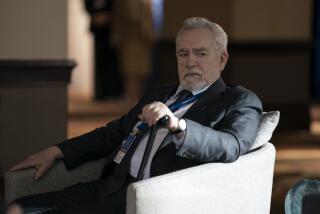Fluor’s Renaissance Led by McCraw’s Push for Creativity
- Share via
Soon after Leslie G. McCraw Jr. was appointed president of Fluor Corp.’s main subsidiary in 1986, he invited a group of children to meet with his top managers to brainstorm solutions to a thorny problem confronting the company.
The fourth- and fifth-graders helped his managers become imaginative in developing fresh ideas about a large, under-utilized building in Texas that was costing the engineering and construction firm millions of dollars a year.
This rather unorthodox management rap session was just one of many creativity sessions that McCraw has required his top managers and others to attend to develop the right--or creative--side of their brains.
That emphasis on creativity was an integral part of his endeavor to shape an innovative team that ultimately executed Fluor’s financial rebound. And McCraw’s success in helping Fluor return to profitability after losing $694 million in 1985 and 1986, has catapulted him to chief executive.
On Jan. 1, McCraw, 55, will take over Fluor’s day-to-day operations from David S. Tappan Jr. By the end of 1990, he will also become chairman, when Tappan retires.
McCraw’s open and imaginative style helped accomplish a renaissance at what some industry analysts said had become a stodgy and demoralized company. According to associates at Fluor, he championed new business practices and encouraged discussion of dissenting views by placing people with opposing styles on a single team.
“We wanted to move people in their thought process from accepting change to embracing change,” said McCraw, a soft-spoken Southerner. “We see change and our ability to react to it quickly in an agile way as our great opportunity.”
McCraw earned the top office at Fluor primarily by merging its two engineering and construction units, Fluor Engineers and Daniel--no mean feat given that the two units had very different business cultures and underlying rivalries. He also reduced the company’s focus on the petroleum industry and turned it into perhaps the most diversified firm in its industry.
Three years after he was assigned the task of merging the subsidiaries--and with the help of a revival of the economy--Fluor is profitable. The company returned to the black in 1987 with earnings of $26.6 million. The upward trend is continuing, with Fluor posting earnings of $108.5 million for fiscal 1989, up 92% from a profit of $56.4 million last year. Fluor Daniel generates 85% of Fluor Corp.’s revenue. The rest comes from coal and lead mining operations.
McCraw is given much of the credit by some industry analysts, who say he has boosted morale and creativity at Fluor. For instance, he has pushed an innovative program in which the company has entered into 15 or more partnerships with clients to help plan and work on their construction projects, eliminating the bidding process. These partnerships, McCraw says, remove the otherwise adversarial relationship between engineering firms and their clients. They also give Fluor insight into its clients’ business, he says, which contributes to better service.
He has also supported the development of an employee incentive program. On an increasing number of Fluor Daniel projects, everyone--from managers to designers and secretaries--shares in the added profit for completing the projects under budget.
“To be able to change the total character of a company the way he has is one of the remarkable stories of management in the country,” said David Bartlett, director of research for Sterling and Yorke, an investment banking firm in New York, who has watched Fluor for more than 25 years.
However, McCraw emphasizes the importance of teamwork. The philosophy that guides him has the ring of the cheerleader that he was in college. He frequently refers to mottoes. A favorite: “There is no limit to what you can accomplish if you don’t care who gets credit.”
Said Allen Dorsey, a securities analyst with the New York brokerage of Dillon Read: “Some people lead by their power, and some people lead by a certain magnetic draw that comes out of their enthusiasm. People follow Les McCraw not because he tells them to but because his enthusiasm is infectious.”
One of McCraw’s first actions upon moving into his luxurious mahogany-paneled executive office in Irvine was to replace the china in the tall cabinets next to his desk with mementos of construction projects: safety buckles, hard hats, photos of ground breakings and a piece of steel welded by Fluor Daniel’s first woman welder. He said this and other memorabilia “warm up the room.”
To illustrate the organizational model that he wants for Fluor, McCraw keeps a sphere made of wood pegs and rubber bands, symbolizing the value of individual employees and their interdependence.
To manage the sprawling Fluor organization--the company has 18,500 employees in 89 countries--McCraw will need all the skills that 67-year-old Tappan sees in him and then some.
Tappan, who picked his successor, said McCraw brings leadership and “comparative youth” to the CEO position and has the advantage of understanding the perspective of client firms because he previously worked for E. I. du Pont de Nemours & Co., the chemical giant, and Gulf Oil Corp. But he acknowledged that McCraw is somewhat weak in his knowledge of the international markets, where Fluor is striving to expand.
Tappan, who was born in China and has extensive international contacts, said McCraw will accompany him overseas in 1990 as part of his continuing education. But, he added that in the long run McCraw “has to develop his own (international) relationships.”
McCraw was raised in rural Sandy Springs, S.C., and earned a civil engineering degree from Clemson University in 1956. After two years each with Gulf Oil and the Air Force, he joined Du Pont. In his 15 years with Du Pont, he worked as an estimator, designer and construction engineer.
Charles D. Brown, a retired vice president of engineering for Du Pont, said McCraw landed one of the plum “grooming” positions in the company, working as an administrative assistant for a construction manager in charge of a dozen or more major jobs.
Brown said that from the beginning he used McCraw as “a sounding board” to determine if upper management would be receptive to certain ideas. McCraw “was smart enough to know how the wind blew,” Brown said.
While at Du Pont, McCraw caught the eye of Charlie W. Cox, president of Daniel Construction in Greenville, S. C. Cox had been impressed with an enthusiastic speech that McCraw had delivered at a celebration for a perfect safety record on a particularly difficult project that Daniel had built for Du Pont under McCraw’s direction.
After the speech, Cox told McCraw: “If you ever want to leave Du Pont, I have a place for you.” McCraw immediately took him up on the offer.
Joining Daniel Construction Co. in 1975 as division manager and vice president of the chemical and fibers group, McCraw rose to become president of the company in 1982 and its chief executive in 1984. In the meantime, Daniel was purchased by Fluor Corp. in 1977.
During his time at Daniel, McCraw said he learned some key management techniques. One is “aggressive listening,” which he learned the hard way after Daniel was fired from a job by TU Electric, a major utility subsidiary of Texas Utilities in Dallas.
Although Daniel was eventually rehired by TU Electric, McCraw said the experience taught him to be more responsive to clients’ needs and desires--an attitude that Fluor managers say he adamantly demands from them today. It was also through TU Electric that McCraw became acquainted with a training course that the utility was using to foster creativity.
Ann McGee-Cooper, a consultant who teaches creative problem solving to corporate leaders, said Fluor put employees, secretaries and spouses through her program. “I think some thought it was crazy. Some questioned his judgment,” she said of McCraw. But in time, she said, the majority were won over.
McCraw said he used the creativity sessions as a vehicle to help mesh the management of the two subsidiaries.
When McCraw was handed the merger assignment in 1986, there was no certainty of success, says Charles Robert Cox, who was McCraw’s first supervisor at Daniel and is a son of Charles W. Cox. Now president of Fluor Daniel’s operations centers, Cox said he would have given the endeavor a 90% chance of failure.
On paper, the two companies always had potential synergy. While 90% of Fluor’s engineering and construction business was overseas, 90% of Daniel’s business was domestic. Daniel primarily hired non-union labor and had a track record of managing smaller and more diverse projects, Fluor had strong ties with construction unions and was renowned for its very large refinery, pipeline and other petroleum-related projects.
For the first decade after Fluor acquired Daniel, there was no pressure to merge the two subsidiaries. But when oil prices began to plummet in the early 1980s, a drastic slowdown followed in oil-related construction projects.
At the same time, Fluor suffered huge losses from an ill-timed investment in natural resources and got embroiled in several money-losing government engineering and construction contracts.
Tappan, who attended to other matters vital to the financial turnaround, said economic necessity finally overcame any reluctance by Fluor’s top management to merge the units.
Cox said McCraw “very gently but firmly pushed the pieces into place and mixed the Fluor and Daniel people so they were always balanced. He put them in the right places with the right personalities.”
Key to the success of the venture, McCraw said, is that philosophically he did not set about merging two existing units. Instead, under Tappan’s direction, he took the approach of building a new company--starting symbolically with a new name and logo--in which neither Fluor nor Daniel would prevail over the other.
As Fluor moves into the 1990s, it is flush with cash and is looking to expand further internationally. Among other things, McCraw said he is hunting for promising “niche” acquisitions “to improve or refine what we do.”
The continual challenge, he said, is to become more profitable. “We have a program we call ‘continuous performance and improvement,’ ” he said. “We reject the adage popular a few years back, ‘If it ain’t broke, don’t fix it.’ We are saying it doesn’t have to be broke to make it better.”
More to Read
Inside the business of entertainment
The Wide Shot brings you news, analysis and insights on everything from streaming wars to production — and what it all means for the future.
You may occasionally receive promotional content from the Los Angeles Times.









